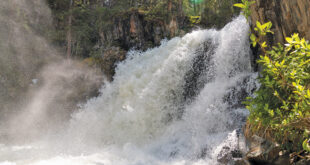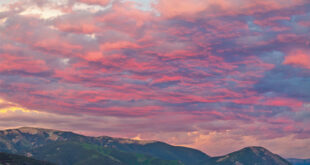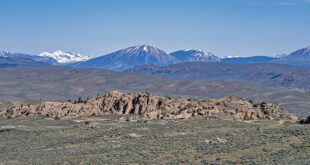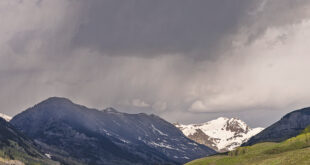Like most of us here now, I came here in part for the recreation opportunities. There were fewer recreational prospects back in the day, but the same foundation remains today—easy, nearby access to gorgeous trails and backcountry adventure along with a small but unusual ski hill that can challenge the finest of skiers (of which I am not one). The main town is small and picturesque, and the village of people must share some hardships like a long winter so there is a communal bond. The wide-open valley is filled with gorgeous views unimpeded by typical development. Those initial elements still factor in as significant reasons to stay or visit here. By digging down even just a little bit, it is easy to see one major player in the valley deserves much of the credit for keeping the foundation intact: working ranches in the valley.
Most of us living in the valley appreciate the expansive, verdant vistas that pretty much stretch between Gunnison to Crested Butte and beyond Gothic. Many of the newer people here might not understand that those vistas are there in large part because of the historical Gunnison County cattle ranching community. In a valley that has no doubt shifted from mining and ranching to a resort focus over the decades, having working ranches is unusual in a primarily amenity-based economy. It is also a blessing.
In this edition of the Crested Butte News, we are running the final part of a three-part series touching on how ranchers view and deal with recreation. There are not many, but there are some industries or businesses in the valley that probably would have an easier time without any recreation — ranching is one. The impacts that come with recreational amenities aren’t a positive for them. Their operational lives would be a lot easier without bikers and hikers. Whether it is moving cattle up to Forest Service land for summer grazing or monitoring gates, the job would be a lot easier without the added recreationist element and associated impacts such as the traffic that come with it.
But it is what it is — and the longtime local ranching families have done a good job of adjusting to new realities… realities they would probably prefer not to deal with. The challenge now is for recreationists—like myself—to embrace the equation that keeps this a unique place.
I raise my eyebrows when I hear people complain about the impacts of ranching in the valley. It drives me a little nuts when I hear fellow bikers or hikers bitch about the cows on the trails. Dealing with cow pies, and their aftermath, is part of our charm. People who are upset that they have to share public lands with ranchers and cattle come across too often as entitled.
When I first got here the ranching community packed a powerful county political influence. While still a strong voice, that is not as much the case anymore. Still, it seems to me that the county commissioners and Forest Service have it ingrained in them to listen more closely to the ranchers than to other stakeholders— and I’m good with that even if it stifles my recreation focus a bit.
It’s not hard to start the list of what separates the North Valley from similar resort communities: There is the fact we are at the end of the road; we don’t have stoplights; we are pretty much a one (commercial) street town; our skiing is less family-friendly and more geared to the niche extreme; while certainly growing, we are still a small town surrounded by acres and acres of protected and beautiful natural land and designated wilderness. But the secret sauce might just be the fact that we have cattle instead of condos surrounding the population centers. The cows are on private property, much of it already subdivided by the way, and if the ranches go away, those particular open vistas probably do as well. More condos mean more development which means more people moving here for recreation so you might be sharing the trails with even more of your mysterious friends from places like Ohio (where I grew up).
That doesn’t even take into consideration the resource that is as valuable, if not more valuable, than the land located near a resort community… water. Ranchers here have long standing water rights that under Colorado law belong to them and are early in the line of protection. They could sell those water rights to Front Range developers and the verdant pastures we appreciate between City Market and your front door would instead be dusty fields.
I remember hearing during some planning session years ago the observation that “people won’t drive by a Starbucks to get to another Starbucks.” Hmmm. That’s a good reflection to consider, especially as we at times seem to want what exists in other places or lazily copy their generic solutions to common resort town issues. The question is why would anyone choose to live in or travel to a valley that doesn’t have all the comforts and amenities of most other resorts? Because it is different here, that’s why. If you want those conveniences, they are out there already in places similar to our valley. There are plenty of other “Starbucks” that are closer to major airports, big box stores and professional sports arenas and, and, and…
Again, the things that attracted and kept most of us here and draws like-minded and like-souled people to this valley are things like being at the literal end of the road, a place that has no stoplights, a place with no Costco and a valley that still has more cattle than condos. And if you dig down just a bit to one foundational reason that we are like we are…it is because some of our neighbors are still working their ranches. It is a blessing and for that, we should be grateful.
Our series on ranching and recreation has recorded that the ranching community has adjusted to the rise in recreation, but it hasn’t always been easy and it certainly isn’t getting easier. The question they are asking now, and the one which ends part 3 of the series, is one we all should be asking ourselves in our unique valley… how much is enough? When do we breach the capacity that keeps this place from being just another “Starbucks” in the mountains?
—Mark Reaman
 The Crested Butte News Serving the Gunnison Valley since 1999
The Crested Butte News Serving the Gunnison Valley since 1999






